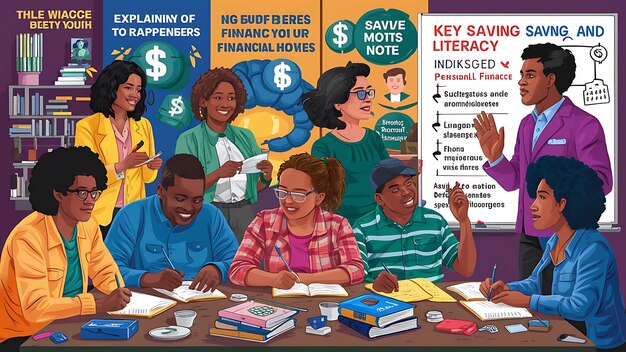Decoding the Racial Wealth Gap: Strategies for Black & Brown Wealth by 2040

Decoding the Racial Wealth Gap: Insider Strategies for Black and Brown Communities to Build Generational Wealth by 2040 involves understanding systemic barriers and implementing targeted strategies like financial literacy programs, homeownership initiatives, and entrepreneurship support to foster generational wealth.
The racial wealth gap in the U.S. is a persistent disparity, but **decoding the racial wealth gap: insider strategies for black and brown communities to build generational wealth by 2040** is achievable through targeted, culturally relevant strategies. Let’s explore how.
Understanding the Landscape of the Racial Wealth Gap
The racial wealth gap isn’t simply an economic issue; it’s a complex interplay of historical injustices, systemic barriers, and ongoing discrimination. Understanding its roots is crucial for crafting effective strategies for change.
Historical Context and its Impact
Generational wealth is often started through actions and policies from the past. Policies like redlining and discriminatory lending practices have historically limited access to homeownership and capital for Black and Brown communities.
Current Systemic Barriers
Even today, disparities persist in education, employment, and access to financial services. These barriers directly impact the ability of Black and Brown communities to accumulate wealth.

- Education Disparities: Unequal access to quality education limits economic opportunities.
- Employment Discrimination: Racial biases in hiring and promotion impede career advancement.
- Financial Service Access: Lack of access to affordable banking and credit perpetuates financial instability.
By understanding the historical and current systemic barriers, we can begin to develop strategies that specifically address these challenges, creating pathways towards economic equity and generational wealth.
Financial Literacy as a Cornerstone
Financial literacy is more than just balancing a checkbook; it’s about understanding how money works, making informed decisions, and building a secure financial future. It’s a cornerstone for building generational wealth within Black and Brown communities.
Culturally Relevant Financial Education
Traditional financial education doesn’t always resonate with diverse communities. Culturally relevant programs address specific challenges and nuances faced by Black and Brown individuals, fostering greater engagement and understanding.
Key Areas of Focus
Effective financial literacy initiatives should cover topics such as budgeting, saving, investing, debt management, and understanding credit. These areas equip individuals with the tools to manage their finances effectively.
- Budgeting and Saving: Creating a budget and establishing saving habits are fundamental steps.
- Investing Fundamentals: Learning about different investment options and risk management is crucial for wealth accumulation.
- Debt Management Strategies: Understanding how to manage and reduce debt is essential for financial stability.
Investing in financial literacy programs tailored to Black and Brown communities empowers individuals to take control of their finances, make informed decisions, and build a solid foundation for generational wealth.

Homeownership: A Pathway to Generational Wealth
Homeownership has long been considered a cornerstone of wealth building in America. For Black and Brown communities, it represents a crucial pathway to closing the racial wealth gap and creating lasting financial security.
Overcoming Barriers to Homeownership
Addressing systemic barriers like discriminatory lending practices and lack of down payment assistance is essential. Programs that provide financial counseling and support can help potential homeowners navigate these challenges.
The Importance of Equity Building
Building equity in a home is a powerful way to accumulate wealth over time. As property values appreciate, homeowners build a valuable asset that can be passed down to future generations.
- Down Payment Assistance Programs: Providing grants or loans to help cover down payment costs.
- Financial Counseling: Offering guidance on credit repair, budgeting, and mortgage options.
- Fair Lending Practices: Ensuring equal access to mortgage products and services.
Promoting homeownership within Black and Brown communities creates a tangible asset that can generate wealth, provide stability, and contribute to long-term financial security for families and future generations.
Entrepreneurship and Small Business Development
Entrepreneurship provides a powerful avenue for Black and Brown individuals to create wealth, build economic power, and contribute to the economic vitality of their communities. Supporting small business development is a crucial strategy.
Access to Capital and Resources
Securing funding can be a significant hurdle for aspiring entrepreneurs. Providing access to capital through grants, loans, and venture capital is essential for launching and scaling businesses.
Mentorship and Training Programs
Mentorship and training programs offer invaluable guidance, skills development, and networking opportunities. These resources help entrepreneurs navigate the challenges of starting and growing a successful business.
- Microloan Programs: Providing small loans to startups and early-stage businesses.
- Business Incubators: Offering affordable workspace, resources, and mentorship to entrepreneurs.
- Networking Opportunities: Connecting entrepreneurs with potential investors, partners, and customers.
Investing in entrepreneurship and small business development within Black and Brown communities empowers individuals to create their own economic opportunities, generate wealth, and build thriving businesses that contribute to the economic well-being of their communities.
Investing in Education and Human Capital
Education is a powerful equalizer and a critical driver of economic opportunity. Investing in education and human capital development is essential for empowering Black and Brown communities to achieve their full potential.
Scholarships and Grants
Providing financial assistance through scholarships and grants can help alleviate the burden of tuition costs, making higher education more accessible to students from underserved communities.
Skills Training and Workforce Development
Investing in skills training programs that align with in-demand industries can equip individuals with the skills and knowledge they need to secure well-paying jobs and advance their careers.
- STEM Education Programs: Encouraging participation in science, technology, engineering, and mathematics fields.
- Vocational Training Programs: Providing hands-on training for skilled trades and technical occupations.
- Apprenticeship Programs: Offering on-the-job training and mentorship in various industries.
By investing in education, skills training, and workforce development, we can create pathways to economic mobility for Black and Brown individuals, empowering them to secure better jobs, earn higher incomes, and build a brighter future for themselves and their families.
Promoting Financial Inclusion and Access to Banking
Financial inclusion ensures that everyone has access to affordable and reliable financial services, including banking, credit, and insurance. Promoting financial inclusion is essential for empowering Black and Brown communities to build wealth and achieve financial stability.
Addressing Banking Deserts
Many Black and Brown communities lack access to traditional banking services, creating “banking deserts.” Establishing branches and ATMs in underserved areas is crucial for providing access to essential financial services.
Offering Affordable Financial Products
Providing access to affordable banking products, such as low-fee checking accounts and small-dollar loans, can help individuals manage their finances effectively and avoid predatory lending practices.
- Mobile Banking Solutions: Expanding access to banking services through mobile apps and online platforms.
- Financial Literacy Workshops: Providing in-person and online workshops on budgeting, saving, and credit management.
- Partnerships with Community Organizations: Collaborating with local organizations to provide financial education and resources.
Promoting financial inclusion and access to banking services empowers Black and Brown communities to manage their finances, build credit, save for the future, and participate fully in the economy.
| Key Point | Brief Description |
|---|---|
| 📚 Financial Literacy | Understanding money management is vital for building wealth. |
| 🏡 Homeownership | Owning a home can create generational wealth through equity. |
| 💼 Entrepreneurship | Starting a business can generate income and build economic power. |
| 🏦 Financial Inclusion | Access to banking services helps manage & grow finances effectively. |
Frequently Asked Questions
▼
The racial wealth gap refers to the disparity in wealth accumulation between white households and households of color, particularly Black and Hispanic families. This gap is often attributed to historical injustices and systemic inequities.
▼
Financial literacy empowers individuals to make informed decisions about budgeting, saving, investing, and debt management. This knowledge is crucial for building financial security and creating wealth.
▼
Homeownership allows families to build equity over time, creating a valuable asset that can be passed down to future generations. This provides financial stability and the opportunity for wealth accumulation.
▼
Entrepreneurship provides individuals with the opportunity to create their own businesses, generate income, and build economic power. Small businesses can drive economic growth and create jobs in communities.
▼
Financial inclusion ensures that everyone has access to affordable and reliable financial services, enabling them to manage their money effectively, build credit, and save for the future, thus fostering financial stability.
Conclusion
Addressing the racial wealth gap requires a multi-faceted approach that tackles systemic barriers, promotes financial literacy, supports homeownership and entrepreneurship, invests in education, and fosters financial inclusion. By implementing these strategies in a targeted and culturally sensitive manner, we can strive towards a more equitable and prosperous future for Black and Brown communities by 2040.





